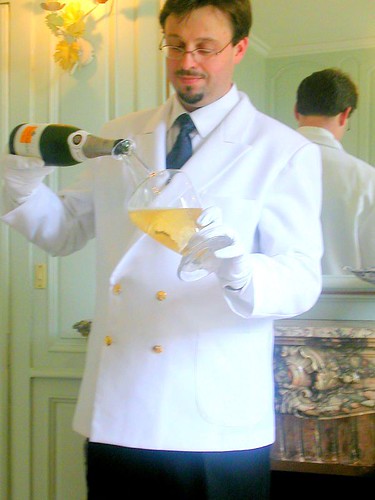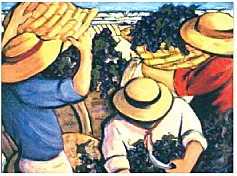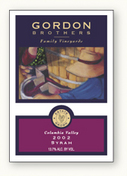September 23, 2006
Poison to the people
Used to be, spinach was for sissies like Popeye. Now that it's off-limits, though, everyone wants it. It's a perfect storm of politics and nature.
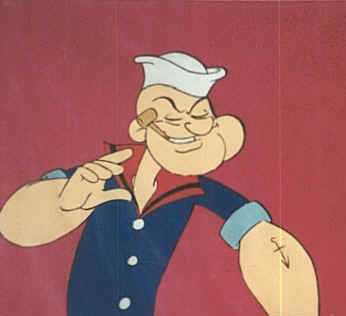
Steak houses like to serve creamed spinach with their sirloin. The steaks come from cattle raised on grain (specifically, genetically engineered corn). But cows aren't intelligently designed to digest the corn properly; the acidity in their ruminant stomachs changes, allowing excessive amounts of (naturally occuring) E.coli bacteria to remain. As a result, feed lots are awash in cowpies with dangerous concentrations of E.coli leaching into groundwater. It would be more expensive, but the cows could be fed, gulp, grass or silage; within a week, the E.coli would be essentially neutralized. Still, that wouldn't cleanse the contaminated groundwater.
Meantime, in that Third World country known as the Salinas Valley, a migrant worker, poor Pedro the produce-picker, is under pressure from his foreman to pick more, faster. As RobertinSeattle has been pointing out in comments on this blog and elsewhere, Pedro's probably not going to walk all the way to the porta-potty (quarter-mile, usually, for "sanitation reasons") to answer calls of nature.
Gummint scientists are trying to blame birds drinking contaminated water, because the all-too-human explanation is political dynamite.
Just how explosive? The growers and packers, among the most stalwart of Republicans, have finally figured it out: not enough illegal immigrants to pick the crops. And they're pissed! (Hard to get good help, ain't it?)
So here's what we're faced with, Georgie-Boy: your pandering ag policies and your jingoistic immigration reform have spawned a monster: a toxic industrial food chain. You've succeeded beyond the wildest terrorist dreams; you're literally poisoning your own people.
One piece of good news: a study that finds cabernet sauvignon protects against Alzheimer's. (Remember when nobody would say a good word about the health benefits of drinking?) Legit study, too. Mount Sinai Medical School, no less.
September 17, 2006
Decant take it with you
Lunch at Veuve Clicquot. Click for more photos.
There's a brand new "Wine Notes" feature in the Saturday Wall Street Journal, by the paper's terrific wine-writing couple, Dot Gaiter and John Brecher (whose regular "Tastings" column continues to run on Fridays). It's a Q&A, but the WSJ team totally blows the very first question!
Reader from Idaho asks about decanting Champagne. Read the column (below), then look at the picture again: taken during lunch at Veuve Clicquot's vineyard guesthouse on the Montagne de Reims, in July, 2003. It's the Demi Sec, often decanted so that the bubbles don't overwhelm its lush flavors. Rich enough to be served with dessert, or foie gras, for that matter. Delectable!
Wine Notes
By DOROTHY J. GAITER and JOHN BRECHER
September 16, 2006; Page P9
In the years we have been writing our "Tastings" column, we have received thousands of questions about wine from readers. Each week, in this column, we will answer some questions that touch on common themes. We have edited the questions for space. If you have a question, drop us a note at wine@wsj.com. Be sure to include your full name, city and state.
Writing from Provence:
Last night at a good local restaurant here I ordered a bottle of white Côtes-du-Rhône. To my surprise, the waiter-sommelier proceeded to pour the wine into one of those broad, flat-based ship's decanters and swirl it around before pouring it. Then I saw it happening at another table, but this time the waiter poured the contents of his decanter into Champagne flutes. I strained to get a look at the bottle and recognized it as Ruinart Champagne. Is all this merely goofy affectation or is there something going on here that I should know about?
---- Lyman Drake, Ketchum, Idaho
We rarely decant (unless a wine is throwing a great deal of sediment) because we like to taste wines from beginning to end, as they open and change with time and air. But we know there are some people who feel that even some good whites can benefit from decanting, especially when they don't have time to linger over the wine for a long time. We had never heard of decanting Champagne, so we sent this note along to Ralph Hersom, the former wine director at New York's Le Cirque 2000, who now owns Ralph's Wines & Spirits in Rye, N.Y. He responded: "I have never seen nor heard of it. In sommelier school, we were always taught to 'preserve the bubbles' -- one reason why you should always attempt to open the bottle as softly as possible (no loud pop sending the cork flying!). It almost sounds as if this sommelier is the child of some former customers of mine who used to request swizzle sticks to get rid of the bubbles in the Champagne they were drinking. Imagine my amazement after they spent several hundred dollars on a fine vintage Champagne and would swirl and swirl until the bubbles were gone."
September 12, 2006
Nice to be noticed
Always satisfying to get recognition, isn't it? National recognition at that, for two Seattle companies.
For Belltown's Flying Fish, it's the "Restaurant of the Year Grand Award" from a respected trade mag, Santé. And for Seattle-based InTouch Travel, it's having one of only six "World's Great Wine Tours" in the October issue of Food & Wine.
Kitchen crew and grilled scallops appetizer at Flying Fish.
Santé (which reaches a quarter-million hospitality professionals) cites Flying Fish for its commitment to sustainable food and its professional achievement. It's the only peer-judged restaurant-and-hospitality awards program in North America; Flying Fish was the only northwest restaurant even mentioned. (The Fish, we just want to point out, was our choice for Belltown restaurant of the year (see our 2005 Belltown Bravo! Awa@rds). Last year, Canlis and its sommelier Shayne Bjornholm won the Santé Grand Award for Wine Hospitality.
Speaking of wine: the tour cited by Food & Wine, designed and marketed by InTouch, is led by an English Master of Wine who lives in Bordeaux, James Lawther. (InTouch was also mentioned in the New York Times recently for its innovative cultural programs.) Before she started InTouch, founder Andrea Nims was VP/GM at my previous company, the now-moribund France In Your Glass.
The only other French wine tour on the list, in Burgundy, is run by Lauriann Greene, another erstwhile Seattle resident who had her own classical music show on KUOW for several years before she moved to France. Yes, she also worked for me, all-too-briefly. Sent her off to get some real-world experience. Did she ever.
September 11, 2006
Don't lettuce poison you
Gulp! As if the world weren't dangerous enough, the latest news from California is particularly disturbing. Seems that lettuce and spinach from the Salinas Valley might be contaminated with the dreaded E. coli O157:H7 bacteria.
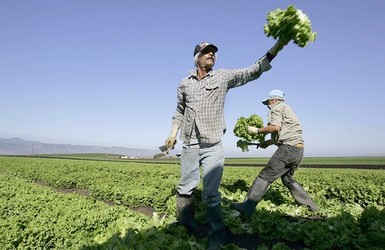
Picking lettuce south of Monterey. Los Angeles Times photo
The last time we saw this, it was undercooked Jack-Inda-Box burgers and improperly pasteurized Odwalla juice. This time the excuse is convoluted: infected cow manure gets into streams that overflow into nearby feedlots and pastures; birds drink the water and drop polluted poop as they fly over the lettuce fields. One blighted head of lettuce, the processors argue, could taint the whole operation. Might. Ya can't prove nothin'.
Only solution, short of steaming or sautéing your salad: buy from local farmers, wash the leaves.
September 9, 2006
Fishy questions, fishy answers
In the wild, salmon are carnivores; unlike, say, vegetarian cattle, they eat smaller fish on the road to our dinner plate. So here's the conundrum: should we buy a fish that's literally eating up the ocean's resources? What's the alternative? Farmed fish raised on an inexhaustible supply of soy pellets, a burger from a feedlot steer, an industrial chicken?
These musings prompted by an op-ed in today's NYTimes by novelist Paul Greenberg. Yeah, fish is fish, but eat smaller fish, he says, to avoid mercury and PCB contamination, and don't buy the cheap stuff; spend what it takes to support the more expensive (but better-for-the-ocean) line-caught fisheries. Lots of save-the-salmon groups out there, too. Long Live the Kings, sponsors of a recent salmon dinner at Flying Fish, focuses on hatchery reform, as good a place as any to start.
Meanwhile, at Fisherman's Terminal, the annual Fall Festival. Highlight: the Wild Salmon Fillet Challenge. So help me, the winner of the heat we videotaped was one "Speedy" Gonzales. YouTube link here. We bailed before they got to the Lutefisk Eating Contest.
September 7, 2006
Chicken breast for the soul
News from Tampa that a culinary team from Swedish Hospital has won the national championship at the HFM cook-off . (That's the National Society for Healthcare Foodservice Management, dontcha know.) Swedish had already won the annual Ivy Award from the trade mag Restaurants & Institutions two years ago for serving the best, er, institutional food in the country.
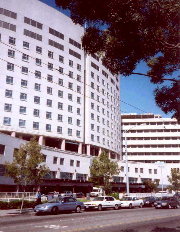
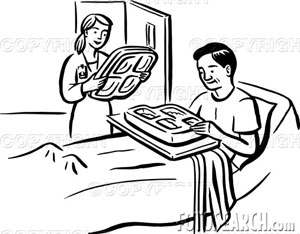
Now before you start snickering, ask yourself where it's written that sick people have to eat cold, disgusting crap off a tray thrust at them in their time of misery by some dismal orderly. A tray that 90 percent of the time, by the way, gets dumped into the garbage untouched. Wouldn't it be nice, the thinking goes, to be able to order a tuna melt on rye when you wake up ravenous at 2 AM? Or a midmorning snack of cookies and ice cream? Why not, indeed.
Swedish, to its credit, hired a nutritionist named Robert Caudle to change the staff's approach to food service, which is now in the hands of his successor, Kris Schroeder, and a Paris-trained executive chef,
Eric Eisenberg. Their team of cooks feed 2,000 patients a day; because patients order what they want, when they want it, they actually eat the food, and the hospital actually saves money. The winning dish whipped up by the Swedish crew for the Florida judges: Mojito Chicken Cubanos al Espeton, no less, served with manchego fondue and savory mango-pinto bean purée. (Want the recipe? Click here.)
Footnote: why chicken breast? Ah, because Tyson, that stalwart of corporate and institutional foodservice, was a sponsor. A reasonable tradeoff? Or yet another example of the pervasive influence of agribiz on our industrial food chain?
September 6, 2006
The International Farmer
Who would you think grows the best syrah in the world? A French guy in the Rhône Valley, no doubt. The celebrated wines of the Côte Rôtie and Hermitage are 100 percent syrah, after all. Or maybe a bloke from Australia, where syrah provides the backbone for the legendary Penfold's Grange Hermitage? Wrong! It's a one-time potato farmer from Pasco!
Decanter, the British wine magazine, holds a competition each year to taste wines from all over. And it turns out, this year, that the medal for the world's best syrah was awarded to a winery from eastern Washington: Gordon Brothers.
Gordon was one of three North American wineries previously named "regional" winners (the others: Ravenswood and Stags Leap), and was the only American winery among the 29 international medalists.
Jeff Gordon, who founded the winery with his brother Bill in 1980, started as a potato farmer with cherries, apples and grapes planted in the sagebrush overlooking the Snake River. He currently serves as chairman of the Washington Wine Commission.
Winemakers carry on about "crafting" wines in the cellar. Hooey. Farmers like Gordon know: it's all about the grapes, stupid. His 2002 Syrah sells for about $20. "It's a testament to the fruit of the Columbia Valley," he says.
It's not the only honor this week for Washington wines. Wine Enthusiast has put Quilceda Creek of Snohomish on the short list ("Wine Stars") for American Winery of the Year.
September 5, 2006
Belltown Barbecue
Labor Day's come and gone, signaling the end of summertime picnics and backyard BBQ.
No worries, though, for us yardless Belltowners. They do a fine 'cue at Frontier Room with their own smoker. Chef Paul Michael starts with the indispensable dry rub (semi-secret blend of salt, sugar, paprika, chili powder, cayenne, mustard, onions, garlic, etc.). Chickens and ribs get 4 to 6 hours of the slow, moist heat; brisket and pork get the overnight treatment.
As you can imagine, the result isn't meat slathered in red goo, as Tony Roma and his gang do it. This is Tennessee or Memphis-style, a different animal entirely. Much, much more subtle, with natural juices and flavors coming from the meat, not some dousing of hot ketchup. If you're so inclined, you can add your own sauces: Tabasco, chipotle, or my choice, the house-made pepper-vinegar, a bold but not overwhelming condiment that's simultaneously sour and spicy.
What do drink with this? Go ahead, order a brew if you like. But barbecue this mouthwatering deserves better. Yes, I'm talking about wine, friends. For the grilled prawns ($9.95), which make an elegant seafood starter, there's a sparkling pink Crémant d'Alsace ($7.50 a glass). Once you get to the meat of things, try easy-drinking reds like Fess Parker's Frontier Red (made around the corner from my brother's place in the Santa Ynez valley), or LAN from the Rioja or Six Prong from eastern Washington, all under $7 a glass. And if you want to splurge, by all means go for Longboard Syrah, produced in the Napa Valley by Israeli surfer-dude Oded Shakked ($110 buys you a whole bottle). As smooth and elegant as a perfect Roundhouse Cutback.
Frontier Room, 2203 First Ave., 206-956-RIBS

September 4, 2006
Keep on forking?
You guys know Charles Ramseyer, the executive chef at Ray's Boathouse, right. Off duty, on the patio at the Elliott Bay Marina, he's having a beer and giving Cornichon a suggested "tag line" for the new videos we'll be posting.
Yes? No? Comments appreciated. Thanks!
September 1, 2006
No Hour Left Unhappy
Used to be, Happy Hour was, oh, 3 to 5, the idea being to let your neighborhood alcoholics start early so they wouldn't interfere with your after-work crowd. That got to be 4 to 6, precisely to attract the after-work crowd, then 5 to 7, which is now pretty much Seattle's standard. About half the places with early-evening drinks specials have added late-night happy hours as well, 10 to midnight, 10 to closing, that sort of thing. One would think we're a nation of drunks, using those in between hours to sleep it off.
Nope, no longer. Now See Sound Lounge (115 Blanchard; SSL to its friends) is weighing in with a mid-evening Happy Hour, 8 to 10 PM. Recognizing that most of its patrons have already had a bite and a drink by the time they arrive for the late-night music scene, SSL's Kristi Anderson decided to entice them in a bit earlier than usual. Rotating lineup of beers and cocktails for $3. Not just drinks, either: everything on the menu is $5, including SSL's signature crab cakes with lemon aioli. And the movie (last night it was Stanley Kubrick's classic "A Clockwork Orange") thrown in, with the house DJ's techno soundtrack.
So now, with Happy Hour at Umi Sake House running until 8, the whole evening's covered. What a town!
Footnote: have just spent a week in California, where Happy Hours are few and far between. Guess they're happy enough already.
